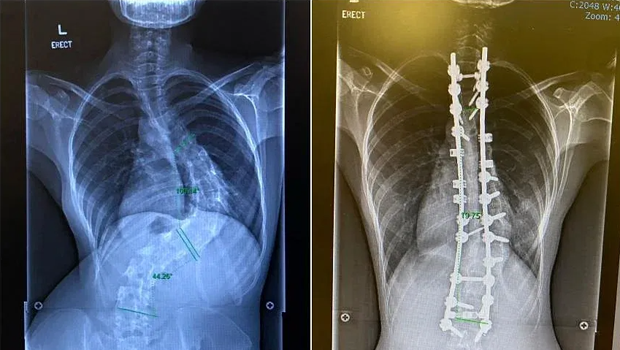
To correct severe scoliosis (left), Ms Natasha Ramli had to have two titanium rods and 20 screws implanted in her back (right). PHOTOS: NATASHA RAMLI
SINGAPORE – Lugging heavy backpacks to school and having poor posture have often been blamed for spinal deformities in pre-teen and teenage girls.
Not anymore.
The reason behind scoliosis, or curvature of the spine, lies in the brain, a team of researchers from the Singapore General Hospital (SGH) and the National Neuroscience Institute (NNI) has discovered in a study.
The most common form of scoliosis is known as adolescent idiopathic scoliosis (AIS), which typically occurs in teenagers, mostly girls. It has no known cause but is believed to be linked to genetics.
Using high-resolution and quality diffusion tensor imaging MRI to map the brain of 34 participants aged between 16 and 27, the researchers found that patients with AIS have differences in certain wiring in the brain that plays an important role in controlling posture and balance.
“This is a nerve pathway that projects downwards from the area of the brain (cortex) controlling movement, posture and balance, towards the brainstem and spinal cord,” said Professor Lo Yew Long, a senior author of the study.
“Our findings suggest that in AIS patients, there are differences in the structure of this tract when comparing the left and right sides.”
Prof Lo, who is also a senior consultant with the Department of Neurology of NNI@SGH, told The Straits Times that what the study found could have already been present very early in life, leading to an imbalance of side-to-side muscular control, resulting in spinal curvature over time.
Associate Professor Reuben Soh, an orthopaedic surgeon with SGH and the study’s first co-author, added: “We see patients as young as 10 years old and oftentimes, parents have the misconception that it’s bad habits or lifestyle factors that are the cause of scoliosis.
“We embarked on this study to try uncovering the real reason and in doing so, we hope to be able to better care for patients and support them and their families in managing the condition.”
The study was completed in 2020 and published in the peer-reviewed journal Clinical Radiology in February 2024.
Symptoms of AIS include abnormal spine curvature and uneven shoulders, hips, and waist. The condition affects about 3 per cent of all adolescents in Singapore, the majority of whom are girls.
There is no cure for it. But in most cases, the spine curvature is not severe and not at risk of further progression, and patients are able to manage their condition with physiotherapy.
“(Our) discovery suggests that scoliosis is fundamentally related to our brain and spinal cord. It could bring about changes in the way AIS is diagnosed or treated,” Prof Lo said. “For example, neurological interventions may potentially be employed to prevent worsening of spine curvature. This could include the use of magnetic fields or low electrical currents to stimulate or modulate brain activity.”
The SGH scoliosis clinic sees about 300 cases a year. About 5 per cent to 10 per cent of patients have AIS severe enough to require complex spine surgery, without which nerve damage or breathing problems result.
Community relations manager Natasha Ramli, 25, is among those who had to undergo spinal surgery for the condition.
“I was diagnosed at age 11 during one of those health screenings in primary school, and I was referred to a specialist. He recommended that I wear a body brace to correct my spine. That did not work out well and I stopped wearing the brace,” she told ST. Her scoliosis became progressively worse, measuring 80 degrees 10 years later. Surgical intervention is usually needed when the curvature exceeds angles of 45 to 50 degrees.
“I suffered back pains, developed uneven hips and had trouble breathing. When the surgeon discovered how severe the curve was, I was told to go for surgery if I wanted a good quality life,” she said. She had two titanium rods and 20 screws implanted in her back.
“I gained 8cm in height. I was rather disoriented after I became taller,” Ms Natasha said, laughing.
Spine surgeons in the public and private sectors saw a surge in the number of teenage girls needing surgical intervention to correct severe scoliosis when health screenings in schools resumed in June 2020 after the Covid-19 circuit breaker lockdown.
Several physiotherapists said home-based learning and the lack of physical activities exacerbated the situation.
KK Women’s and Children’s Hospital saw a significant jump in 2021 from both the “backlog of cases from the height of the pandemic” and the hospital’s usual caseload where the spine curvature exceeds angles of 45 to 50 degrees.
Looking ahead, the team behind the study hopes to conduct further studies on a larger cohort incorporating genomics, and using more advanced MRI modelling to potentially identify those at risk of developing AIS or AIS progression, and even to understand why more girls are at higher risk.













 Get it on Google Play
Get it on Google Play